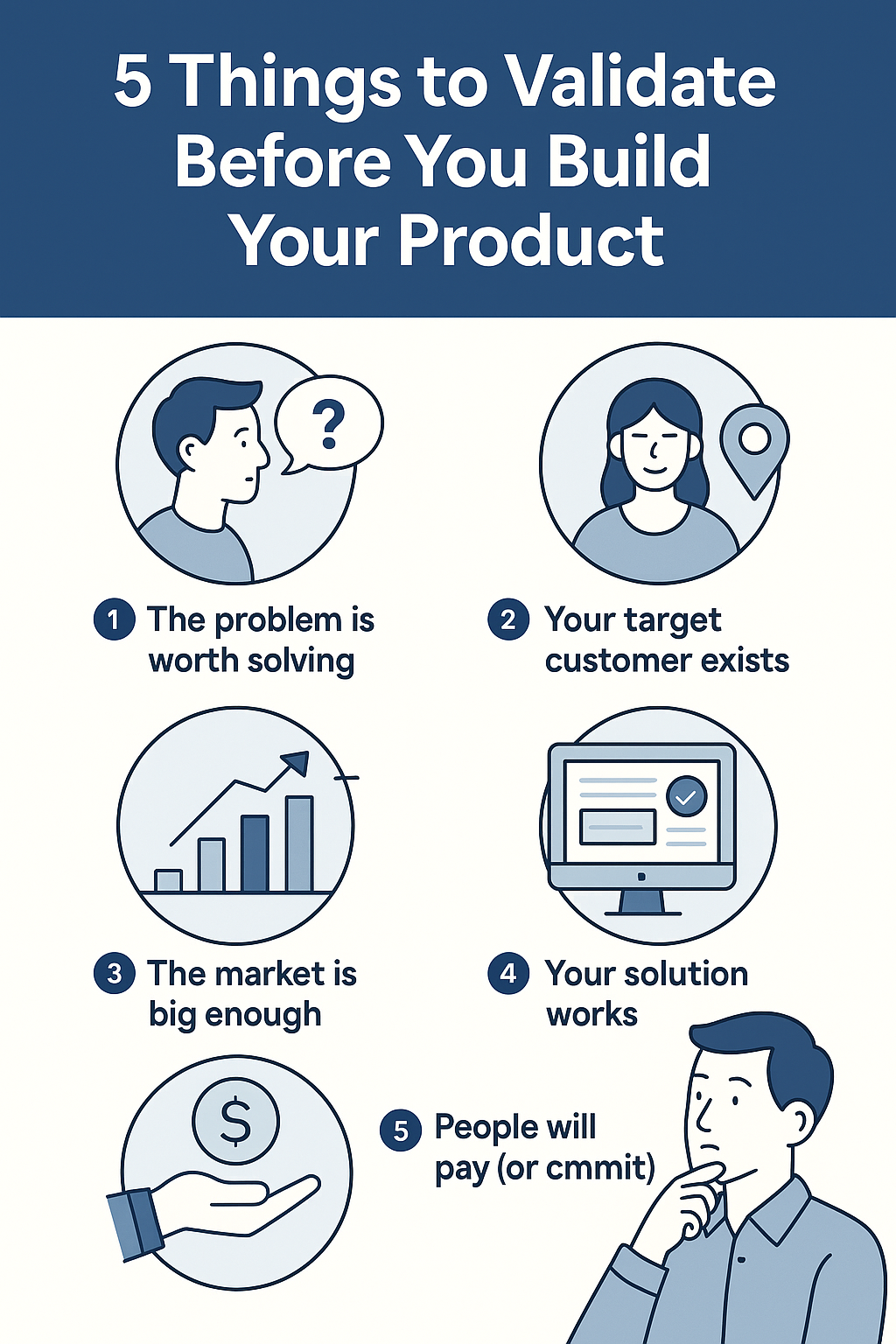Introduction: The Cost of Building Before Validating
Many startups fail not because they can’t build their product, but because they build the wrong product—something nobody actually wants. Founders get excited, dive into development, and burn through precious time and capital, only to discover too late that the market doesn’t care.
If you’re a startup founder, validation is your safety net. It lets you test assumptions, save money, and increase your chances of success—all before writing a single line of code. Here are five crucial things you need to validate before you start building.
Why Validation Is Critical to Startup Success
Avoiding Costly Mistakes Early
Building takes time, and time is money. Validating first helps you confirm you’re on the right path before making big investments.
Aligning Product Vision with Market Needs
You may think your product idea is brilliant, but if your users don’t see it that way, it won’t sell. Validation connects your vision to real-world demand.
Saving Time, Money, and Reputation
Nothing hurts more than launching to silence. Validating your idea ensures there’s an audience waiting for your product.
Validation #1: The Problem Is Real and Worth Solving
Before building anything, ask: Is this a real problem people actually care about?
Conducting Problem Interviews
Talk to 10–15 potential users. Ask open-ended questions like:
- “What’s your biggest frustration with [topic]?”
- “How do you currently solve this issue?”
Look for patterns, not polite praise.
Identifying Frequency and Pain Level
If it’s a once-a-year inconvenience, it won’t make a strong business. Look for pain points that are frequent, frustrating, and costly.
Distinguishing Between a Nuisance and a Necessity
People don’t pay for mild annoyances—they pay to solve real pain. Validate that your problem is mission-critical to your user.
Validation #2: Your Target Customer Exists and Can Be Reached
A great product means nothing if you can’t find your users.
Creating Precise User Personas
Define your early adopters:
- Age, profession, goals
- Behavior patterns
- Where they spend time online
Using Surveys, Forums, and Social Listening
Go where your users already hang out—Reddit, Slack communities, LinkedIn groups—and observe their problems in real time.
Testing Acquisition Channels Early
Run small, cheap campaigns on social media or Google Ads to test interest and engagement. Can you attract the right audience?
Validation #3: The Market Opportunity Is Big Enough
Your product might work, but is there room to grow?
Estimating Market Size (TAM, SAM, SOM)
- TAM (Total Addressable Market): Everyone who might need your product
- SAM (Serviceable Available Market): The segment you can realistically reach
- SOM (Serviceable Obtainable Market): The customers you can acquire in your early phase
Analyzing Competitive Landscape
Check how crowded the space is. Can you offer something better, cheaper, or more focused?
Identifying Trends That Support Growth
Look for emerging behaviors or shifts that support long-term demand. Think remote work, AI adoption, or sustainability.
Validation #4: Your Solution Actually Solves the Problem
It’s not enough to know the problem—you have to prove your solution is viable.
Prototyping and Wireframing
Use tools like Figma, Marvel, or InVision to build clickable mockups and test flow before you build.
Gathering Real User Feedback
Show your prototype to real users. Ask them to complete tasks while thinking aloud. Watch for friction or confusion.
Testing for Usability and Desirability
Is the solution easy to use? Do users feel excited about it? These are early signs of product-market fit.
Validation #5: People Are Willing to Pay (or Commit)
Love is nice. Money is better. Validation isn’t complete until people show real commitment.
Pre-Selling and Early Adopter Programs
Offer early access, discounts, or lifetime deals. If people pay upfront, they believe in your product.
Running Smoke Tests and Landing Page Experiments
Build a simple page describing your product and track:
- Email signups
- Click-through rates
- Interest in pricing tiers
Collecting Email Signups or Deposits
Even without charging, email signups show demand. Better yet, ask for a small deposit—it filters out tire-kickers.
Bonus: How to Document and Interpret Validation Results
Using Validation Boards or Tracking Tools
Tools like Notion, Miro, or a simple spreadsheet can help track interview results, key quotes, and recurring themes.
When to Pivot, Persevere, or Pause
Use your findings to decide:
- Pivot if users love the problem but not the solution
- Persevere if interest is strong and feedback is clear
- Pause if there’s no meaningful demand or urgency
Conclusion: Build What’s Needed, Not Just What’s Possible
Startup founders are builders by nature. But great founders build wisely—only after validating that what they’re building truly matters. Validate the problem, the audience, the market, the solution, and the willingness to pay. Your future self (and your bank account) will thank you.
FAQs on Validating Product Ideas
1. How long should the validation phase take?
Typically 2–4 weeks is enough to validate a basic idea.
2. Can I validate my idea without a product?
Yes! Use interviews, mockups, and landing pages to test demand.
3. What if people say they’re interested but don’t commit?
Interest without action is not validation. Look for behavior, not compliments.
4. How many user interviews should I do?
Start with 10–15. If you’re hearing repeated patterns, you’re on the right track.
5. Should I pivot if the market is crowded?
Not necessarily. If your niche or angle is unique and validated, you can still win.
6. What if I get mixed feedback?
Focus on your ideal customer segment. Don’t build for everyone—build for someone specific.

